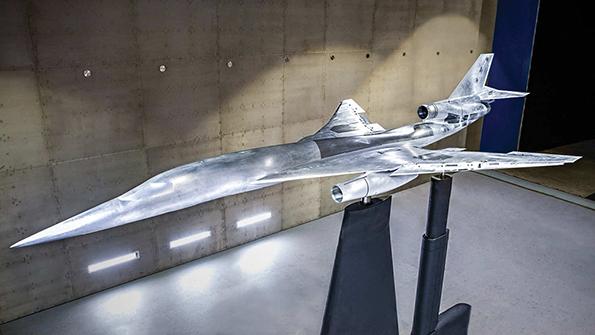
Commercial aircraft design in the West has entered a long, quiet winter. From Bombardier to Boeing-—which is shuttering its Seattle-area Advanced Developmental Composites facility—no new subsonic passenger aircraft currently is expected from legacy OEMs until the latter half of the decade at the soonest.
But a new type of passenger aircraft looks to shatter the placidness with sonic and business booms alike. This technological leap for the masses could be good for parts of the aerospace industry but bad for others, according to a new report from analysts and researchers at a major investment bank.
In December, UBS released a report titled “The Need for Speed: How will Supersonic Jets Transform the Travel Industry?” Drafted by a dozen analysts led by Myles Walton and backed by the UBS Evidence Lab data research team, the 43-page document outlines an array of potential commercial supersonic market outcomes but with a clear expectation for sizable growth regardless of how specifics play out.
At the midpoint of its scenarios, UBS says the cumulative size of the commercial supersonic new aircraft market could be about $160 billion by 2040, including $85 billion for business jets. The best-case scenario—whereby supersonic airliners and bizjets meet performance and manufacturing promises, quell regulators over noise and entice retail customers with digestible ticket prices—sees a $280 billion market. But even the worst scenario is still $80 billion.
How would this come about? In the end, it comes down to the attraction of speed. In a separate but related survey, UBS asked travelers why they would be willing to get on a hypersonic spaceplane that flies five times the speed of sound or ride in a supersonic aircraft. The No. 1 reason: quicker travel, especially internationally. Nearly 35% of flyers would be willing to pay more than a 25% premium for the faster travel time.
Naturally, any paradigm shift brings winners and losers. The analysts believe existing aerospace providers would be the most significantly affected, starting with legacy high-end bizjet-makers that most likely are at risk of disruption as “non-price-sensitive” customers gravitate to the new offering. The public companies least likely to benefit from this trend include Airbus, Boeing, Bombardier, Embraer and General Dynamics. Most likely to benefit are Hexcel, Raytheon Technologies, Rolls-Royce and Virgin Galactic.
The market that UBS envisions revolves around 2040, by which time supersonic transportation will likely have taken hold. While the analysts doubt aircraft entry into service will occur before late this decade at the earliest, they do expect a parade of developments, including flight tests in about five years.
UBS says it is watching for Aerion’s new manufacturing facility in Melbourne, Florida, and potentially other manufacturers, to ramp up initial manufacturing in coming years, and it expects flight tests by the middle of this decade. That jibes with what Aviation Week’s Business & Commercial Aviation (BCA) and Weekly of Business Aviation have recently heard from supersonic market executives.
“Within the next four years, you will see aircraft in the air breaking the sound barrier, built by commercial companies,” Hermeus co-founder and CEO AJ Piplica predicted in December.
“The momentum is really building,” Aerion Chief Financial Officer Matthew Mejia echoed in the BCA podcast this month. The company’s order backlog is up to roughly 50 aircraft, worth $6.7 billion. “We’re targeting trying to build the orderbook as aggressively as we can,” he added. “We do want to sell 300 aircraft over 10 years.”
As exciting as all this is for the newcomers, it does not guarantee they will sweep the field. Developing supersonic bizjets is seen as a multibillion-dollar endeavor. Last summer, when space tourism candidate Virgin Galactic unveiled its plan to provide high-speed point-to-point travel, observers groaned at the cost burden.
“Relative to our going-in expectation,” Vertical Research Partners says, “Virgin Galactic’s strategy seems likely to (A) be a bigger near-term cash drag since much of the technology to go build this likely exists today, and (B) offer a lower ultimate payoff as it leads Virgin away from its unique core competency, down a path crowded with competitors who are pursuing or have unsuccessfully pursued similar concepts.”
What is more, the UBS team stresses that startups do not always reign in the end: “As we’ve seen with many other ‘new’ technologies, it’s not always the first mover that dominates the market, but often it’s the company that takes the extra time to potentially learn from the mistakes of others that ultimately develops the market-leading product.”




Comments
Isn't it crystal clear that hypersonic commercial aircraft are impractical?